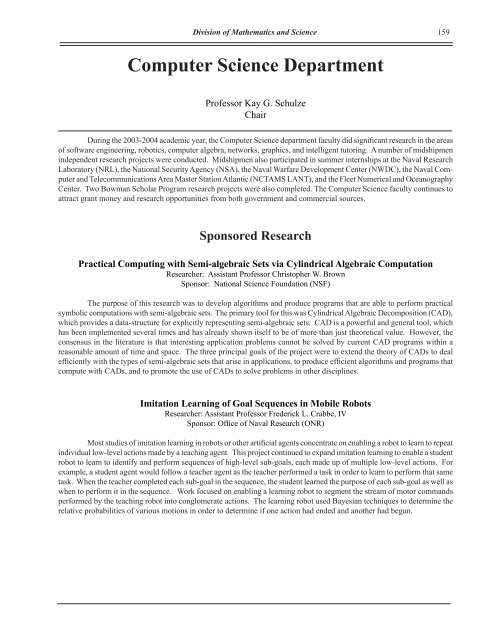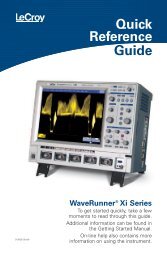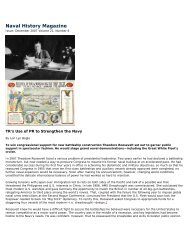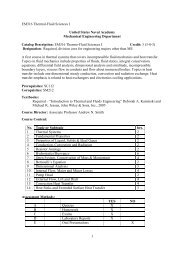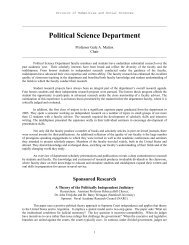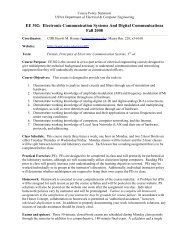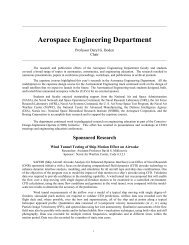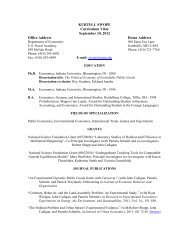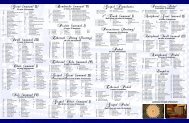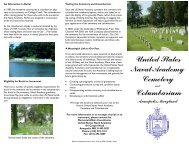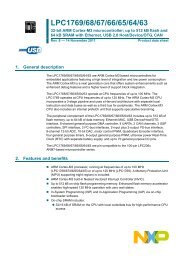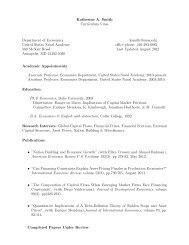Computer Science Department - United States Naval Academy
Computer Science Department - United States Naval Academy
Computer Science Department - United States Naval Academy
- No tags were found...
You also want an ePaper? Increase the reach of your titles
YUMPU automatically turns print PDFs into web optimized ePapers that Google loves.
Division of Mathematics and <strong>Science</strong>159<strong>Computer</strong> <strong>Science</strong> <strong>Department</strong>Professor Kay G. SchulzeChairDuring the 2003-2004 academic year, the <strong>Computer</strong> <strong>Science</strong> department faculty did significant research in the areasof software engineering, robotics, computer algebra, networks, graphics, and intelligent tutoring. A number of midshipmenindependent research projects were conducted. Midshipmen also participated in summer internships at the <strong>Naval</strong> ResearchLaboratory (NRL), the National Security Agency (NSA), the <strong>Naval</strong> Warfare Development Center (NWDC), the <strong>Naval</strong> <strong>Computer</strong>and Telecommunications Area Master Station Atlantic (NCTAMS LANT), and the Fleet Numerical and OceanographyCenter. Two Bowman Scholar Program research projects were also completed. The <strong>Computer</strong> <strong>Science</strong> faculty continues toattract grant money and research opportunities from both government and commercial sources.Sponsored ResearchPractical Computing with Semi-algebraic Sets via Cylindrical Algebraic ComputationResearcher: Assistant Professor Christopher W. BrownSponsor: National <strong>Science</strong> Foundation (NSF)The purpose of this research was to develop algorithms and produce programs that are able to perform practicalsymbolic computations with semi-algebraic sets. The primary tool for this was Cylindrical Algebraic Decomposition (CAD),which provides a data-structure for explicitly representing semi-algebraic sets. CAD is a powerful and general tool, whichhas been implemented several times and has already shown itself to be of more than just theoretical value. However, theconsensus in the literature is that interesting application problems cannot be solved by current CAD programs within areasonable amount of time and space. The three principal goals of the project were to extend the theory of CADs to dealefficiently with the types of semi-algebraic sets that arise in applications, to produce efficient algorithms and programs thatcompute with CADs, and to promote the use of CADs to solve problems in other disciplines.Imitation Learning of Goal Sequences in Mobile RobotsResearcher: Assistant Professor Frederick L. Crabbe, IVSponsor: Office of <strong>Naval</strong> Research (ONR)Most studies of imitation learning in robots or other artificial agents concentrate on enabling a robot to learn to repeatindividual low-level actions made by a teaching agent. This project continued to expand imitation learning to enable a studentrobot to learn to identify and perform sequences of high-level sub-goals, each made up of multiple low-level actions. Forexample, a student agent would follow a teacher agent as the teacher performed a task in order to learn to perform that sametask. When the teacher completed each sub-goal in the sequence, the student learned the purpose of each sub-goal as well aswhen to perform it in the sequence. Work focused on enabling a learning robot to segment the stream of motor commandsperformed by the teaching robot into conglomerate actions. The learning robot used Bayesian techniques to determine therelative probabilities of various motions in order to determine if one action had ended and another had begun.
160 <strong>Computer</strong> <strong>Science</strong> <strong>Department</strong>High Energy Laser Weapons: Modeling and Simulation(Phase II, Modeling Development)Researcher: Associate Professor Donald M. NeedhamSponsor: The High-Energy Laser Joint Technology OfficeDevelopment of one or more end-to-end simulations of laser system performance and effectiveness is fundamentalto the goals of the High Energy Laser Joint Technology Office’s (JTO) modeling and simulation (M&S) program. Onesuch simulation prospective follows the physics and engineering of a ship’s energy starting with energy conversion fromthe ship’s fuel through electrical power generation, electrical generation of laser light, beam transport, etc, and ending withtarget damage assessment. A fundamental step, proposed by this research, in the process of developing a domain-reusable,end-to-end high energy laser simulation, was to examine an existing model, and focus on the identification of a softwaresystem architecture designed to support the inclusion of modeling components needed for the various portions of an endto-endsimulation. The steps in this process included acquiring a suitable high energy laser model, and developing an architecturethat isolated and minimized couplings between the software components that implemented the model. Analysisof the resulting architecture focused on increasing its potential for domain-specific reuse so that suitable models for theremaining portions of the end-to-end simulation could be smoothly integrated. Additionally, this work provided guidanceto high energy laser modelers on developing software components that implement their models so as to ease integration oftheir models within an end-to-end simulation.The Andes ProjectResearcher: Professor Kay G. SchulzeSponsor: Office of <strong>Naval</strong> Research (ONR)Classical physics is a prerequisite for virtually all university-level study of science and technology, yet is notoriouslydifficult for students to learn. The Andes project is an intelligent tutoring system that is intended to be used as a “homeworkhelper” for students taking General Physics courses. This year the project concentrated on expanding the number of problemsin the system, particularly in areas traditionally covered in a second semester Physics course.A Particle System Method for Quantifying Cardiac Ejection FractionResearcher: Assistant Professor David J. Stahl, Jr.Sponsors: Office of <strong>Naval</strong> Research (ONR) and <strong>Naval</strong> <strong>Academy</strong> Research Council (NARC)This research first required porting an existing physically-based modeling, visualization and physical simulationenvironment previously developed by the researcher, from its UNIX/SGI implementation to a Windows/PC implementation.Second, an existing volumetric model of a human left ventricle was improved to permit blood pool introduction andejection. This required data conversion and modification to produce an anatomically correct myocardium model with a leftatrium, aorta, and associated valves suitable for use in the simulation system. Third, the particle system model was revisedto allow temporally changing internal model representations to permit the modeling of cardiac valves that open and close.Finally, simulations were run to demonstrate the ability to measure cardiac ejection fraction with this approach.Independent ResearchAn Investigation into Compromise Actions in Behavior-Based Robotic SystemsResearcher: Assistant Professor Frederick L. Crabbe, IVThis project examined the nature of compromise actions in behavior-based systems. Using Value-Iteration toapproximate solutions to the Bellman equation, it determined the comparative advantage to selecting compromise actionswhen pursuing two appetitive goals. It then used Information Gain to determine in what scenarios compromise behaviorprovided the greatest benefit.
<strong>Computer</strong> <strong>Science</strong> <strong>Department</strong>161Md5deepResearcher: Captain Jesse Kornblum, USAFThis research continued the development of md5deep, a cross-platform set of programs that computes MD5message digests or SHA-1 message digests on an arbitrary number of files. The programs run on Windows, Linux,FreeBSD, OS X, Solaris, and should run on most other platforms. Md5deep is similar to the md5sum program found in theGNU Coreutils package, but it has several additional features.Midshipman Research Course ProjectsEvolutionary Software Development and Simulationfor an Urban Search and Rescue RobotResearcher: Midshipman 1/C Jeffrey Pinney, USNAdviser: Assistant Professor Frederick L. Crabbe, IVThe goal of this project was to use genetic algorithms (GA) to develop controls for an already existing robot. Thesecontrols are complex and perform certain functions that accomplish pre-defined search and rescue obstacles. Genetic algorithmswere needed because the complexity was too great to accomplish the controls kinematically. <strong>Computer</strong> simulationwas used in conjunction with the GA for testing. The simulation for testing was completed, and the groundwork for the GAwas put in place. In the future, the GA will be used to develop a controller that effectively controls the robot to perform allthe tasks necessary to be an urban search and rescue robot.Collaborative Networked Environments for Military TrainingResearcher: Midshipman 1/C Keith G. Labbe, USNAdviser: Major Mark J. Lennerton, USMCSponsor: Bowman Scholar ProgramThe research undertaken in this proposal was a joint venture with the <strong>Naval</strong> Postgraduate School (NPS). Oncea secure Virtual Private Network (VPN) connection was established and tested locally, a connection with NPS wasestablished. This connectivity provided and served as a test bed in determining VPN functionality in meeting the needs forcontinued collaborative Virtual Environment (VE) and information technology (IT) research. A commercial off the shelf(COTS) desktop VE was initially used to test issues such as bandwidth requirements/availability, latency, and barriers tocollaborative communication and coordination. Once established, customized and scaled, bicoastal collaborative sessionswere connected to explore performance in pursuit of collaborative goals. Additional collaborative sessions were conductedthroughout to gain a better understanding of the human factors involved in using VEs.High Energy Laser Modeling and Simulation Framework EvaluationResearcher: Midshipman 1/C Erik C. Eckstrand, USNAdviser: Associate Professor Donald M. NeedhamSponsor: Bowman Scholar ProgramThis research centered on the modification of an existing software architecture framework that provided thecommunication backbone between high energy laser propagation models. IT evaluated whether one component of an endto-endsoftware simulation framework, such as a laser’s wave front propagation component, could be modified or replacedto allow for the inclusion of emerging lasing codes, and assessed the impact of such changes on the rest of the simulationframework. This project contributed to the High Energy Laser Joint Technology Office’s efforts by incorporating an existinglaser propagation model into the Northrop Grumman High Energy Laser Simulation (HELSEEM) framework, and examinedthe feasibility of incorporating legacy laser propagation codes into the HELSEEM framework. The specific incorporationprocess was detailed, with particular attention given to problems likely to be encountered by developers of subsequent laserpropagation codes. Lessons learned from the incorporation process, as well as recommendations for the improvement ofthe process, were identified and discussed.
164<strong>Computer</strong> <strong>Science</strong> <strong>Department</strong>CRABBE, Frederick L., Assistant Professor, “Unifying Undergraduate Artificial Intelligence Robotics: Layers Of AbstractionOver Two Channels,” Proceedings of the AAAI Spring Symposium on Hands on Robotics Education, 2004, pp. 2-7.From a <strong>Computer</strong> <strong>Science</strong> and Artificial Intelligence perspective, Robotics often appears as a collection of oftendisjoint, sometimes antagonistic sub-fields. The lack of a coherent and unified presentation of the field negativelyimpacts teaching, especially to undergraduates. This paper presented an alternative synthesis of the varioussub-fields of Artificial Intelligence and robotics, and showed how these traditional sub-fields fit in to the whole.Finally, it presented a curriculum based on these ideas.Darken, Rudolph, Sullivan, Joseph, Commander, USN, and LENNERTON, Mark J., Major, USMC, “A ChromakeyAugmented Virtual Environment for Deployable Training,” 2004.In our attempts to construct virtual environments that simulate certain aspects of the real world, several significanttechnical shortfalls have limited our ability to elicit human behavior in the VE that approximates human behaviorin the real world. The objective of this research was to construct a training system suitable for deployed use thatwas low cost, had a small foot print, and could be shown to have quantitative value as a training device. This paperdescribed a mixed reality appended trainer solution that used a Chromakey technique to mix the real environmentinside the cockpit with the simulated environment outside the cockpit. This apparatus allowed the near-fieldenvironment, including cockpit displays, maps, and controls, to “pass through” while the view out the windowwas replaced with a virtual simulation. It described the initial experiment that determined if helicopter pilots couldeffectively navigate using this system and if their performance was reasonably similar to their performance in anactual helicopter. Results indicate that performance in the trainer did approximate actual performance within realworld threshold values and that techniques for overland navigation used in actual flight also applied directly tonavigation using the trainer.DeLOOZE, Lori L., Lieutenant Commander, USN, McKean, Paul, Mostow, John R., and Graig, Christopher, “Simulationfor Training <strong>Computer</strong> Network Operations,” Proceedings of the 8 th Colloquium for Information Systems Security Education,2004, pp. 329-334.Attacks on <strong>Department</strong> of Defense computer systems are a serious and growing threat. The cornerstone to theprotection of these highly valuable networks is education and training. The U. S. Strategic Command is examininga new tool to train and exercise computer security to determine if the complex concepts relating to computersecurity can be more effectively taught by including simulations in the classroom. The simulation environmentunder investigation consists of both an Internet Attack Simulator and a Network Simulator. The Internet AttackSimulator has a menu of attacks that can be launched against the Network Simulator’s virtual network. Thesystem is essentially an interactive virtual cyber world which requires the student defender to implement securitymeasures and respond to attacks. Novice computer science students and information technology professionalsbenefit from the visualization of cyber behavior afforded in the risk free environment that simulation provides.The simulation reinforced the lecture in both concurrent demonstrations of the principles being taught, and later,in individual practical exercises.DeLOOZE, Lori L., Lieutenant Commander, USN, “Classification of <strong>Computer</strong> Attacks Using a Self-organizing Map,”Proceedings of the 8th Colloquium for Information Systems Security Education, 2004, p. 365-369.As computer technology evolves and the threat of computer crimes increases, the apprehension and preemption ofsuch violations become more and more difficult and challenging. To date, it appears that completely preventingbreaches of security is unrealistic. Therefore, we must try to detect and classify these intrusions as they occur sothat immediate actions may be taken to repair the damage and prevent further harm. One attempt at classifyingthese intrusions is MITRE’s Common Vulnerabilities and Exposures (CVE) list that provides a common namefor all publicly known security weaknesses. The CVE dictionary, however, is not a taxonomy. The CVE list isorganized in simple numerical order by date of acceptance. Each entry in the dictionary includes a unique CVEidentification number, a text description of the vulnerability and any pertinent references.Creating a Self-Organizing Map (SOM) using the text description allowed us to order attack profiles withcommon features in the same general area of the output space. Attacks in the general neighborhood of one another
<strong>Computer</strong> <strong>Science</strong> <strong>Department</strong>165should be able to be mitigated by similar means. Plotting attacks on a SOM also enabled us to visually examinethe placement of an attack relative to the four common classes of attacks (Denial of Service, Deception, Reconnaissance,and Unauthorized Access). Many attacks have features in common with more than one of these classesrather than corresponding directly to a single class. This research developed an effective technique to classifynew attacks using a unique taxonomy, which broke down threats into the four general categories, and the SOMcreated by the baseline CVE descriptions.McMAHON, Margaret M., Assistant Professor, NEEDHAM, Donald M., Associate Professor, and DATKO, Joshua B.,(Trident Scholar, Class of 2002), “Performance of a Jini-Based Ad Hoc Network Authentication Scheme,” Proceeding ofthe 16th International Conference on Parallel and Distributed Computing Systems, 2003, pp. 442-447.Ad hoc networks provide a dynamically reconfigurable network infrastructure where entities can participateat will. Jini technology can be used to implement an ad hoc network, and to permit a user to enter the networkand become a client of services without apriori knowledge of either the existence of the network or its services.However, Jini lacks security provisions for authenticating users of the network. Traditional Public Key Infrastructure(PKI) approaches to authentication in an ad hoc network are static and cumbersome. An alternative approach thatemploys PKI in a dynamic manner, consistent with the rapidly changing nature of ad hoc networks, can providethe basis for such ad hoc authentication.This paper presented an implementation of an algorithm that provides a foundation for secure, ad hoc joiningof a distributed, mobile, wireless network. The approach was based on incorporating the use of a dynamic PKIapproach with the Jini architecture. It described the Java-based implementation of a certification authority hierarchythat supported our authentication process, and analyzed the performance of our implementation. We also examinedthe influence of the Remote Method Invocation Daemon (RMID) in the performance of our implementation.NEEDHAM, Donald M., Associate Professor, McMAHON, Margaret M., Assistant Professor, and DATKO, Joshua B.,(Trident Scholar, Class of 2002), “Ad Hoc Network Authentication: A Jini-based Approach,” Proceedings of the InternationalConference on Wireless Networks (ICWN’03), 2003, pp. 549-553.Ad hoc networks implemented with Jini technology permit users to enter a network, and become clients ofservices, without apriori knowledge of the network or its services. Although traditional Public Key Infrastructure(PKI) approaches to authentication are generally static, we employed PKI in a manner consistent with the dynamicnature of ad hoc networks. This paper presented an algorithm that provided a foundation for secure, ad hoc joinsin a distributed, mobile, wireless network. Our approach incorporated the use of a dynamic PKI approach withina Jin-based architecture. We discussed a Java-based implementation of a certification authority hierarchy thatsupported our authentication process.NEEDHAM, Donald M, Associate Professor, SIMPSON, M., ENS, USN and WHITTEN, B., ENS, USN, “Putting InterdisciplinarySoftware Engineering into Practice, A Java-based Embedded System Controller,” Proceedings of the InternationalConference on Software Engineering Research and Practice (SERP’03), Volume II, 2003, pp. 707-713.Embedded applications provide unique exposure to software development by allowing software engineers toincorporate analysis and design techniques with their knowledge of operating systems, hardware interaction andprogramming level concurrency constructs. This paper presented the design and development of a multi-threadedJava-based control system. We analyzed the impact of team software development, examined design decisions madefrom the perspective of software reuse, evaluated the effectiveness of Java for programming embedded systems,and considered the effect of course sequencing on team development projects.WILCOX, Jeffrey P., Midshipman 1/C (USN), and STAHL, David J., Jr., Assistant Professor, “YP-TDS: A Tactical DataSimulator for a <strong>Naval</strong> <strong>Academy</strong> Yard Patrol Craft,” Proceedings of the 37 th Midwest Instruction and Computing Symposium(MICS). (Electronic publication and recipient of the “best undergraduate student paper” award).The term Network Centric Warfare (NCW) describes the operational environment of the U.S. military in the 21stcentury: linking dispersed battlespace entities to achieve combat effectiveness through information superiority.
<strong>Computer</strong> <strong>Science</strong> <strong>Department</strong>167Presentations at Professional Meetings and ConferencesBROWN, Christopher W., Assistant Professor, a software demonstration of: “QEPCAD B: Computing with Semi-AlgebraicSets,” International Symposium on Symbolic and Algebraic Computation, Philadelphia, PA, August 2003, (winner of thebest software award).CRABBE, Frederick L., Assistant Professor, “Representing a 3-D Environment with a 2 1/2-D Map Structure,” InternationalConference on Intelligent Robotics and Systems (IROS), Las Vegas, NV, 2003.CRABBE, Frederick L., Assistant Professor, “Unifying Undergraduate Artificial Intelligence Robotics: Layers Of Abstraction OverTwo Channels,” AAAI Spring Symposium on Hands on Robotics Education, Stanford University, Palo Alto, CA, 2004.KORNBLUM, Jesse, Captain, USAF, “Hacker Court,” Blackhat Conference, Las Vegas, NV, July 2003 and Tysons Corner,VA, October 2003.LENNERTON, Mark J., Major, USMC, “Exploring a Chromakeyed Augmented Virtual Environment for Viability as anEmbedded Training System for Military Helicopters,” HMT-166 Meeting, Camp Pendleton, CA, March 2004.McMAHON, Margaret M., Assistant Professor, “Implementing a Jini-based Ad Hoc Network Authentication Scheme,”16 th International Conference on Parallel and Distributed Computing Systems, Reno, NV, August 2003.NEEDHAM, Donald M., Associate Professor, “Applying Software Engineering Techniques to the Assessment Process,”Best Assessment Processes VI Symposium, Terra-Haute, IN, March 2004.NEEDHAM, Donald M., Associate Professor, “Ad Hoc Network Authentication: A Jini-based Approach,” InternationalConference on Wireless Networks (ICWN’03), Las Vegas, NV, June 2003.NEEDHAM, Donald M., Associate Professor, “Putting Interdisciplinary Software Engineering into Practice: A Java-basedEmbedded System Controller,” International Conference on Software Engineering Research and Practice (SERP’03), LasVegas, NV, June 2003.SCHULZE, K. G., Professor, WINTERSGILL, Mary C., Professor, (Physics <strong>Department</strong>), SHELBY, Robert N., ProfessorEmeritus (Physics <strong>Department</strong>), and TREACY, Donald J., Professor (Physics <strong>Department</strong>), “Does It Matter How StudentsSolve Physics Problems?,” 127 th American Associate of Physics Teachers, Madison, WI, August 2003.
168


